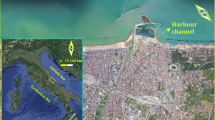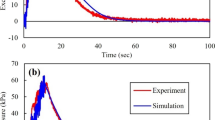Abstract
This paper presents a 2D analytical solution for the transverse velocity distribution in compound open channels based on the Shiono and Knight method (SKM), in which the secondary flow coefficient (K-value) is introduced to take into account the effect of the secondary flow. The modeling results agree well with the experimental results from the Science and Engineering Research Council-Flood Channel Facility (SERC-FCF). Based on the SERC-FCF, the effects of geography on the secondary flow coefficient and the reason for such effects are analyzed. The modeling results show that the intensity of the secondary flow is related to the geometry of the section of the compound channel, and the sign of the K-value is related to the rotating direction of the secondary flow cell. This study provides a scientific reference to the selection of the K-value.
Similar content being viewed by others
References
Yang, K., Cao, S., and Knight, D. W. Flow patterns in compound channels with vegetated floodplains. Journal of Hydraulic Engineering 133(2), 148–159 (2007)
Zhang, M., Shen, Y., and Wu, X. 3D numerical simulation on overbank flows in compound channels (in Chinese). Journal of Hydroelectric Engineering 25(5), 31–36 (2006)
Huai, W., Chen, W., and Tong, H. 3D numerical simulation on overbank steady open channel flows in compound channels (in Chinese). Advances in Water Science 14(1), 15–19 (2003)
Krishnappan, B. G. and Lau, Y. L. Turbulence modeling of floodplain flows. Journal of Hydraulic Engineering 112(4), 251–266 (1986)
Ervine, D. A., Babaeyan-Koopaei, K., and Sellin, R. H. J. Two-dimensional solution for straight and meandering overbank flows. Journal of Hydraulic Engineering 126(9), 653–669 (2000)
Shiono, K. and Knight, D. W. Turbulent open-channel flows with variable depth across the channel. Journal of Fluid Mechanics 222, 617–646 (1991)
Huai, W., Xu, Z., Yang, Z., and Zeng, Y. Two dimensional analytical solution for a partially vegetated compound channel flow. Applied Mathematics and Mechanics (English Edition) 29(8), 1077–1084 (2008) DOI 10.1007/s10483-008-0811-y
Xu, W. Study on computational method of overbank flow in channels with compound cross section (in Chinese). Journal of Hydraulic Engineering (6), 21–26 (2001)
Yang, Z. H. and Gao, W. Two dimensional analytical solution for overbank flows with interaction between the main channel and floodplain (in Chinese). Journal of Sichuan University (Engineering Science Edition) 41(5), 42–46 (2001)
Castanedo, S., Medina, R., and Mendez, F. J. Models for the turbulent diffusion terms of shallow water equations. Journal of Hydraulic Engineering 131(3), 217–223 (2005)
Abbott, M. B. and Price, W. A. Coastal, Estuarial, and Harbour Engineers’ Reference Book, Taylor & Francis, London/New York (1994)
Shome, M. L. and Steffler, P. M. Lateral flow exchange in transient compound channel flow. Journal of Hydraulic Engineering 124(1), 77–80 (1998)
Stelling, G. S., Wiersma, A. K., and Willemse, J. Practical aspects of accurate tidal computations. Journal of Hydraulic Engineering 112(9), 802–817 (1986)
Blumberg, A. F. and Mellor, G. L. A description of a three-dimensional coastal ocean circulation model. Three-Dimensional Coastal Ocean Models (ed. Heaps, N. S.), American Geophysical Union, Washington, DC, 1–16 (1987)
Roig, L. C. and King, I. P. Continuum model for flows in emergent marsh vegetation. Estuarine and Coastal Modeling, Proceedings of the 2nd International Conference (eds. Spaulding, M. L., Bedford, K., Blumberg, A., Cheng, R., and Swanson, C.), ASCE, New York, 268–279 (1992)
Hu, S. and Kot, S. C. Numerical model of tides in Pearl River estuary with moving boundary. Journal of Hydraulic Engineering 123(1), 21–29 (1997)
Benque, J. P., Cunge, J. A., Feuillet, J., Hauguel, A., and Holly, F. M., Jr. New method for tidal current computation. Journal of the Waterway Port Coastal and Ocean Division 108(3), 396–417 (1982)
Darby, S. E. and Thorne, C. R. Predicting stage-discharge curves in channels with bank vegetation. Journal of Hydraulic Engineering 122(10), 583–586 (1996)
Balzano, A. Evaluation of methods for numerical simulation of wetting and drying in shallow water flow models. Coastal Engineering 34(1–2), 83–107 (1998)
Huai, W., Gao, M., Zeng, Y., and Li, D. Two-dimensional analytical solution for compound channel flows with vegetated floodplains. Applied Mathematics and Mechanics (English Edition) 30(9), 1121–1130 (2009) DOI 10.1007/s10483-009-0906-z
Tang, X. and Knight, D. W. A general model of lateral depth-averaged velocity distributions for open channel flows. Advances in Water Resources 31(5), 846–857 (2008)
Knight, D. W., Omran, M., and Tang, X. Modeling depth-averaged velocity and boundary shear in trapezoidal channels with secondary flows. Journal of Hydraulic Engineering 133(1), 39–47 (2007)
McGahey, C. A Practical Approach to Estimating the Flow Capacity of Rivers Application and Analysis, Ph. D. dissertation, Open University, Milton Keynes, UK (2006)
Ikeda, S. Self-formed straight channels in sandy beds. Journal of the Hydraulics Division 107(4), 389–406 (1981)
Chlebek, J. and Knight, D. W. A new perspective on sidewall correction procedures, based on SKM modelling. Proceedings of the International Conference on Fluvial Hydraulics (eds. Ferreira, R. M. L., Alves, E. C. T. L., Leal, J. G. A. B., and Cardosa, A. H.), Taylor & Francis, London/NewYork, 135–144 (2006)
Author information
Authors and Affiliations
Corresponding author
Additional information
Communicated by Shi-qiang DAI
Project supported by the National Natural Science Foundation of China (No. 50749031) and the Doctoral Fund of the Ministry of Education of China (No. 20070486022)
Rights and permissions
About this article
Cite this article
Yang, Zh., Gao, W. & Huai, Wx. Secondary flow coefficient of overbank flow. Appl. Math. Mech.-Engl. Ed. 31, 709–718 (2010). https://doi.org/10.1007/s10483-010-1305-9
Received:
Revised:
Published:
Issue Date:
DOI: https://doi.org/10.1007/s10483-010-1305-9




